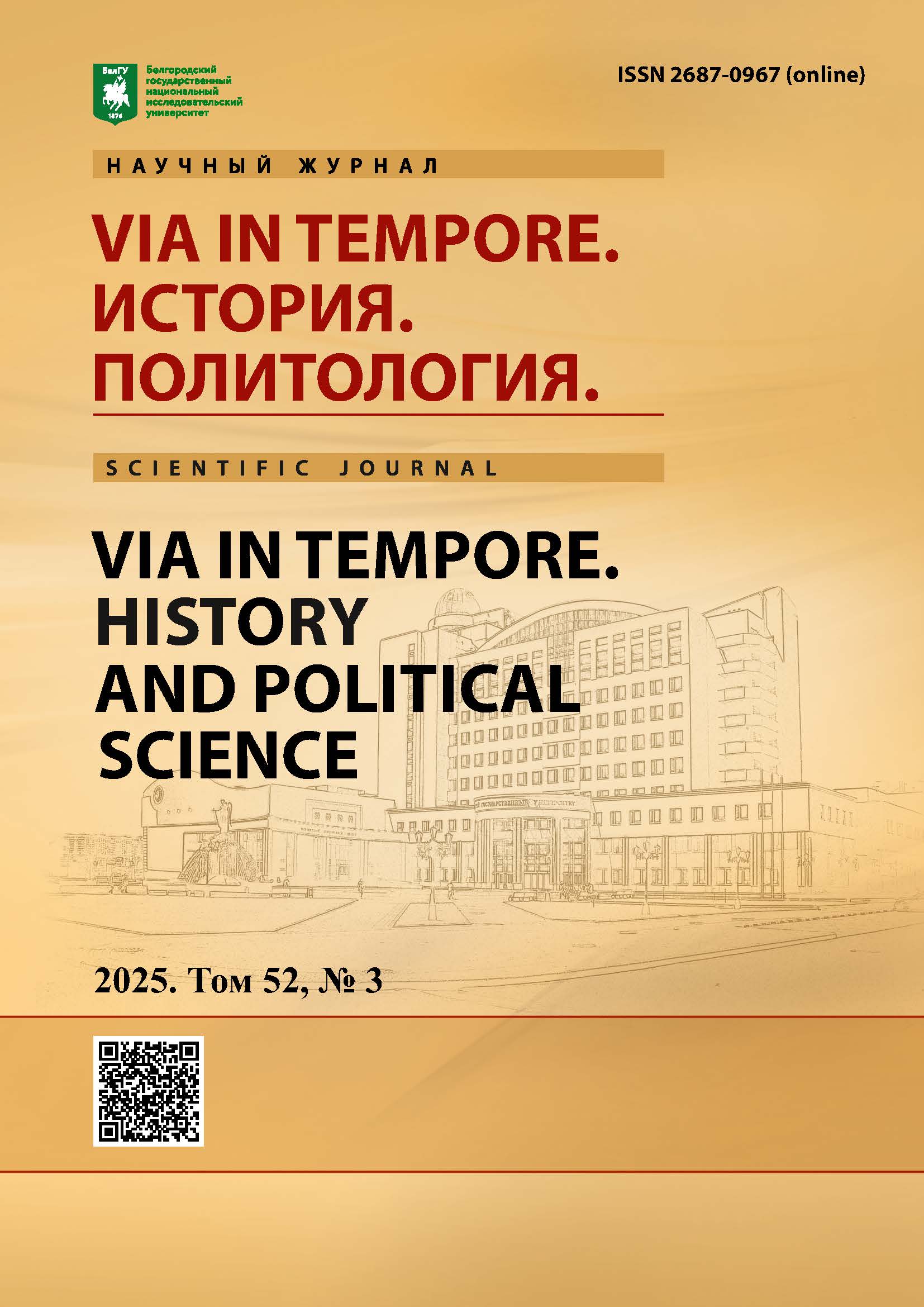К вопросу о причинах и факторах экономического развития Палестины в ранневизантийский период: проблемы реконструкции
DOI:
https://doi.org/10.52575/2687-0967-2025-52-3-578-591Ключевые слова:
ВВизантийская Палестина, экономика, климатические изменения, торговые сети, сельскохозяйственные инновации, археология, междисциплинарный анализАннотация
Статья предлагает взгляд на общую модель развития экономики палестинского региона в византийскую эпоху (IV–VII вв.). Обобщающая реконструкция модели развития проводится через синтез климатических, археологических и социально-экономических данных на основе междисциплинарного подхода. В основной части работы автор попутно анализирует конкурирующие исторические концепции развития византийской Палестины (модель Э. Хантингтона, теория Д. Бара и др.), показывая, что процветание региона стало результатом комплексного взаимовлияния климатического оптимума в позднеантичную эпоху, специфики развития государственной производственной инфраструктуры, специфических демографических явлений и экономического сдвига в средиземноморской торговле. Особое внимание уделено многочисленным климатическим, а также внутри- и внешнеполитическим «вызовам» (по А. Тойнби), которые стали причиной коллапса устоявшейся экономической модели в VII в. Автор особо подчёркивает сложность взаимодействия природных и антропогенных факторов в развитии византийской экономики на региональном уровне, а также обращает внимание на последовательный отказ историков и археологов от монокаузальной модели ранневизантийского развития данного региона.
Скачивания
Библиографические ссылки
Список литературы
Al-Shorman A., Shiyab A. The Effect of Function on the Selection of Raw Materials and Manufacturing Technology of Byzantine Pottery: A Case Study from Qasr Ar-Rabbah, South Jordan. In: Palestine Exploration Quarterly, 147(1): 4–19.
Avi-Yonah M. 1958. The Economics of Byzantine Palestine. In: Israel Exploration Journal, 8(1): 39–51.
Bar D. 2004 In: Population, Settlement and Economy in Late Roman and Byzantine Palestine (70–641 AD). In: Bulletin of the School of Oriental and African Studies, 67: 307–320.
Blanckenhorn M.L.P. 1912. Naturwissenschaftliche Studien am Toten Meer und im Jordental Bericht über eine im Jahre 1908. Berlin, Verlag von R. Friedländer & Sohn, 478.
Crown A.D. 1972. Toward a Reconstruction of the Climate of Palestine 8000 B.C. – 0 B.C. In: Journal of Near Eastern Studies, 31(4): 312–330.
Dan Y. 1982. The Foreign Trade of Palestine in the Byzantine Period. In: Cathedra: For the History of Eretz Israel and Its Yishuv, 23: 17–24.
Decker M. 2007. Frontier Settlement and Economy in the Byzantine East. In: Dumbarton Oaks Papers, 61: 217–267.
El-Khouri L. 2007. Roman and Byzantine Settlements in the Region of West Irbid. In: Palestine Exploration Quarterly, 139(3): 166–185.
Gichon M. 1974. Fine Byzantine Wares from the South of Israel. In: Palestine Exploration Quarterly, 106(2): 119–139.
Gregory J.W. 1930. Palestine and the Stability of Climate in Historic Times. In: The Geographical Journal, 76(6): 487–494.
Hirschfeld Y. 1997. Farms and Villages in Byzantine Palestine. In: Dumbarton Oaks Papers, 51: 33–71.
Hirschfeld Y. 2004. A Climatic Change in the Early Byzantine Period? Some Archaeological Evidence. In: Palestine Exploration Quarterly, 136(2): 133–149.
Huntington E. 1908. The Climate of Ancient Palestine. Part I. In: Bulletin of the American Geographical Society, 40(9): 513–522.
Huntington E. 1908. The Climate of Ancient Palestine. Part II. In: Bulletin of the American Geographical Society, 40(10): 577–586.
Huntington E. 1908. The Climate of Ancient Palestine. Part III (Conclusion). In: Bulletin of the American Geographical Society, 40(11): 641–652.
Kennedy H. 2008. Syria, Palestine and Mesopotamia. In: The Cambridge Ancient History. Late Antiquity: Empire and Successors, A.D. 425–600. Cambridge, Cambridge University Press: 588–611.
Kingsley S. 2001. The Economic Impact of the Palestinian Wine Trade in Late Antiquity. In: Economy and Exchange in the East Mediterranean during Late Antiquity. Proceedings of a conference at Somerville College, Oxford – 29th May, 1999. Oxford, Oxbow Books: 44–68.
Magen Y. 2008. Oil Production in the Land of Israel in the Early Islamic Period. In: Judea and Samaria: Researches and Discoveries [Judea and Samaria Publications (Series), 6]. Jerusalem, Israel Antiquities Authority: 257–343.
Magness J. 1993. Jerusalem Ceramic Chronology (circa 200–800 CE). Sheffield, Sheffield Academic Press, 277.
Patrich J. 1994. Map of Deir Mar Saba (109/7). Jerusalem, Department of Antiquities and Museums, 295.
Saidel B.A. 2005. Four Days at Khalasa: Using Aerial Photography and GIS Analysis to Reappraise Woolley and Lawrence’s Survey of Byzantine Elusa in the Western Negev Desert. In: Palestine Exploration Quarterly, 137: 53–64.
Salem H. 2011. Khirbet Siya: A Byzantine Settlement in Ramallah Region – Palestine. In: Liber Annuus, 61: 575–619.
Taxel I. 2013. The Olive Oil Economy of Byzantine and Early Islamic Palestine: Some Critical Notes. in: Liber Annuus, 63: 361–394.
Tubb J.N. 1986. The Pottery from a Byzantine Well near Tell Fara. In: Palestine Exploration Quarterly, 118(1): 51–65.
Просмотров аннотации: 10
Поделиться
Опубликован
Как цитировать
Выпуск
Раздел
Copyright (c) 2025 Via in tempore. История. Политология

Это произведение доступно по лицензии Creative Commons «Attribution» («Атрибуция») 4.0 Всемирная.


